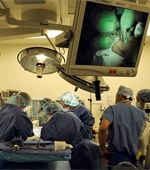High-Risk Breast Cancer Patients May Not Need a Mastectomy
An abstract presented at the 13th Annual Meeting of the American Society of Breast Surgeons suggests that women who are at high risk for recurrence may not need a mastectomy.
An abstract presented at the 13th Annual Meeting of the American Society of Breast Surgeons, “Biology, Not Choice of Mastectomy versus Lumpectomy, Dictates Recurrence in High-Risk Breast Cancer,” suggests that women who are at high risk for breast cancer recurrence may not need a mastectomy. The data was presented by Elizabeth Cureton, MD, the University of California in San Francisco. The study asked whether breast conservation for high-risk women is safe.

Surgeons perform a mastectomy on a patient
As part of the I-SPY prospective neoadjuvant trial, patients who had had either a mastectomy or lumpectomy were followed for a median of 3.9 years. Follow-up care included serial MRIs and molecular profiling analyses. Nine clinical centers participated in the trial.
All patients had invasive breast cancer with tumors greater than 3 cms. Overall, local recurrence was low. Of 157 patients, 35 had distant recurrence with no signs of local recurrence; 10 patient had distal recurrence, either synchronous with local recurrence or within 2 years of local recurrence.
The 4-year trial classified patients as high risk based on factors such as tumor size, node status, and genetic markers. These factors dictated choice between mastectomy and lumpectomy. All patients underwent aggressive neoadjuvant chemotherapy in addition to surgery.
Patients with local recurrence alone were rare-only four patients had local recurrence with no distal recurrence. This observation led to the hypothesis that aggressive tumor biology underlies distal recurrence, irrespective of surgery type.
Analysis of patients in the I-SPY 1 registry confirmed that treatment type could not predict rates of recurrence. The 5-year survival of patients who had either a lumpectomy or a mastectomy were almost the same-79% vs 72%, respectively (P = .22).
Dr. Cureton and her team concluded that local and distal recurrence is affected by aggressive biology and response to treatment, and not by surgery type. They also suggest that if radiation therapy is suggested, breast conservation should be attempted. Breast conservation surgery generally leads to less potential for surgical complications, and the surgery is safe for higher risk patient populations, particularly when patients also receive radiation therapy as part of their treatment.
Further studies should help clarify whether mastectomy rates could be drastically decreased without sacrificing patient outcomes.